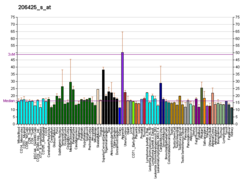Function
Non-specific cation conductance elicited by the activation of TrkB by BDNF is TRPC3-dependent in the CNS. [8] TRPC channels are almost always co-localized with mGluR1-expressing cells and likely play a role in mGluR-mediated EPSPs. [9]
The TRPC3 channel has been shown to be preferentially expressed in non-excitable cell types, such as oligodendrocytes. [6] However, evidence suggests that active TRPC3 channels in basal ganglia (BG) output neurons are responsible for maintaining a tonic inward depolarizing current that regulates resting membrane potential and promotes regular neuronal firing. [10] Conversely, inhibiting TRPC3 promotes cellular hyperpolarization, which can lead to slower and more irregular neuronal firing. While it's unclear if TRPC3 channels have equal expression, other members of the TRPC family have been localized to the axon hillock, cell body, and dendritic processes of dopamine-expressing cells. [11]
The neuromodulator, substance P, activates TRPC3/7 channels inducing cellular currents that underlie rhythmic pacemaker activity in the brainstem, enhancing the regularity and frequency of respiratory rhythms, [12] showing homology to the mechanism described in BG neurons. Transgenic cardiomyocytes expressing TRPC3 show prolonged action potential duration when exposed to a TRPC3 agonist. [13] The same cardiomyocytes also increase their firing rate with agonist exposure under a current-clamp tetanus protocol suggesting that they may play a role in cardiac arrhythmogenesis.
This page is based on this
Wikipedia article Text is available under the
CC BY-SA 4.0 license; additional terms may apply.
Images, videos and audio are available under their respective licenses.





